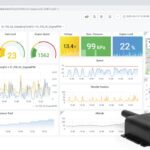Understanding whether your 2000 Mercedes-Benz requires a special OBD2 code reader is a common question for car owners delving into DIY diagnostics and maintenance. The On-Board Diagnostics II (OBD2) system became a standard feature in vehicles sold in the United States starting in 1996. This standardization was designed to make vehicle diagnostics more accessible and uniform. For owners of a 2000 Mercedes, it’s essential to know if this luxury vehicle adheres to the standard OBD2 protocols, or if it demands a specialized tool to read diagnostic trouble codes effectively.
OBD2 Compliance and Your 2000 Mercedes
The good news for Mercedes-Benz owners, including those with models from the year 2000, is that these vehicles are indeed OBD2 compliant. By the model year 2000, OBD2 was well-established across the automotive industry, including European manufacturers like Mercedes-Benz. This means your 2000 Mercedes is equipped with the standard 16-pin Diagnostic Link Connector (DLC), typically located within two feet of the steering wheel column. It also means that the car communicates using the standardized OBD2 protocols for emissions-related diagnostics.
However, while the fundamental OBD2 system is standard, it’s important to understand the nuances when it comes to diagnostic tools. A basic, generic OBD2 code reader, readily available at auto parts stores or online, will generally work to retrieve basic diagnostic trouble codes (DTCs) from your 2000 Mercedes’ engine control unit (ECU). These codes are primarily related to emissions and powertrain issues, which are the core focus of the OBD2 standardization.
Decoding Beyond the Basics: Mercedes-Specific Diagnostics
While a standard OBD2 reader will likely connect to your 2000 Mercedes and pull generic codes, the depth of diagnostic capability can vary. Mercedes-Benz, like many European car manufacturers, often incorporates proprietary diagnostic systems and enhanced codes beyond the basic OBD2 requirements. This means that for more in-depth diagnostics, especially concerning systems beyond the engine and emissions – such as the антиблокировочная система (ABS), подушки безопасности (SRS), transmission, or chassis – a generic OBD2 reader might fall short.
For comprehensive diagnostics on a 2000 Mercedes, particularly if you are encountering issues beyond the typical engine light, a more advanced scan tool is often recommended. These enhanced scanners can access Mercedes-specific codes and systems that generic readers might miss. They often offer functionalities like live data streaming for various modules, actuation tests, and more advanced reset functions tailored to Mercedes-Benz vehicles.
Choosing the Right OBD2 Reader for Your 2000 Mercedes
So, does your 2000 Mercedes need a “special” OBD2 code reader? Not necessarily in the sense that it uses a completely different physical connector or communication protocol for basic engine diagnostics. A standard OBD2 reader will likely work for reading common engine-related fault codes.
However, to get the most out of your diagnostic efforts, especially for a sophisticated vehicle like a Mercedes-Benz, considering a scan tool that offers enhanced compatibility with Mercedes vehicles is advisable. Look for OBD2 scanners that advertise enhanced OEM coverage or specific Mercedes-Benz compatibility. These tools are designed to delve deeper into your vehicle’s systems, providing a more thorough diagnostic picture and potentially saving you time and money in the long run by pinpointing issues more accurately. For basic code reading, a generic OBD2 scanner will get you started, but for comprehensive Mercedes diagnostics, an enhanced tool is the better investment.
